Cockroaches are known for eating anything, including each other. Cannibalism may be a disturbing trait to many, but loyalty to their species has never stopped a roach from picking its own survival over others in its colony.
Cockroaches eat other cockroaches. Cannibalism can occur if a roach has no other food, is overcrowded in a nest, lacks nutrients, or has a mating dispute. Larger roaches will be driven to eat their eggs, nymphs (young), and smaller adult roaches. Cockroaches of all ages may eat dead cockroaches and shed skins.
The primary motivation of roaches will always be species survival and preservation. Cockroaches prefer to eat dead cockroaches, not live ones. If things are dire, they may eat their own poop.
Do Cockroaches Eat One Another?
Cockroaches do eat each other, but it will not be their first instinct. Roaches will not choose their own kind over food. That’s because roaches are scavenging insects rather than hunters. In the wild, they rely on eating:
- Rotted wood
- Decaying leaf matter
- Fruits, berries, or other vegetation that’s started to rot
- Animal carcasses or the bodies of other insects
In the average home, they will eat leftover food, organic waste like hair, or trash. The time, effort, and danger of contending with live food that can fight back is too much risk.
Nonetheless, cockroaches are resilient creatures that will not accept starvation. This can lead to them to biting humans, pets and eating each other. Let’s explore the reasons why cockroaches eat other cockroaches:
Overpopulation
Roaches live in large colonies. As long as there’s ample space to contain all members of the nest, they will exist in harmony. In fact, they will leave scent trails to guide new members to food and shelter, expanding their numbers. However, overpopulation leads to overcrowding, where not all members will have access to:
- Shelter
- Water
- Food
In these cases, you’ll find that roaches naturally thin out their colony. Large roaches will take it upon themselves to eat smaller members to create more room. Any that have injuries or lost limbs, which make it difficult for them to escape or fight back, may fall victim. It’s literally survival of the fittest.
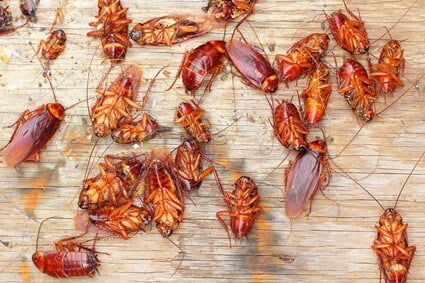
A Lack of Food
If roaches live in a home that’s well cleaned and free of exposed leftovers, they will be in dire need of food. This mounting hunger will encourage roaches to eat whatever is nearby, which is often other colony members. In the later stages of an extermination plan, you may find the population cannibalizing itself out of desperation.
If you haven’t practiced any pest control, it’s a sign that the population has grown exponentially. More specifically, to the point where the food sources available aren’t enough to sustain the colony.
Harsh Conditions
Roaches thrive in almost any conditions. With that said, they are cold-blooded creatures that are unable to create their own body heat. If temperatures drop to or below freezing, their metabolism will begin to slow down.
This may not kill them, but it will mean that roaches struggle to produce the energy they need to function. That’s why you may find roaches cannibalizing each other in the winter months or in areas where they can’t find appropriate warmth. They need nutrients, and other members of their species will suffice as a food source.
Mating Conflicts
Spiders and praying mantis are not the only creatures where females can eat the males during mating. Some cockroach species will see the female turn on the male and devour him.
This is a rare behavior but usually has a clear motivation. The female may deem her nutrient stores to be lacking. Though most roaches don’t carry their young inside a womb, they still need to devote resources to the eggs. If the female cannot do so, she may seek other members of her species to make up for the deficiency.
According to the Asian Food Science Journal, cockroaches provide nutrients. One roach can offer:
- Moisture
- Crude ash
- Crude protein
- Fiber
- Carbohydrates
- Nitrogen extract
That’s not to mention the nutrients found in rarer species of cockroaches, the likes of which can produce milk.
Do Cockroaches Eat Other Dead Cockroaches?
In line with their cannibalistic tendencies, a roach will eat other dead cockroaches. It’s not just a self-preservation tactic, nor is it a meaningless desecration of a corpse. This habit actually benefits the ecosystem.
Biotropica explains that cockroaches are a clade of detritivore-herbivore insects. Other sources also claim that cockroaches are omnivorous. What this means is that cockroaches can, and will, eat detritus. This includes leaf litter, rotting fruit, and decaying bodies. That ensures that cockroaches recycle what other animals leave behind.
In digesting this matter, cockroaches process it and turn it into waste which fertilizes the earth for new growth. Instead of leaving dead cockroaches to waste away, live roaches can tidy up the mess. This ensures nitrogen is properly released into the air, helping the environment.
With that said, roaches won’t immediately eat their own dead. That’s because, upon death, cockroach bodies release oleic acids. These fatty acids produce a ‘death scent’ to warn other cockroaches away from potential danger.
Over time, this scent fades away. If nearby roaches are hungry, and the scent is powerful enough, they will overcome their fear. The corpse presents free food that doesn’t require a fight, and they’ll take that opportunity.
Do Cockroaches Eat Their Young?
According to the Journal of Economic Entomology, cockroaches eat their young. These baby roaches are called nymphs. It is suggested that by eating young, cockroaches are self-regulating their population. After all, if there are more individuals in a colony, the resources can become strained.
However, most roaches don’t seek out their young as easy meals. They will be driven to it.
Nymphs Can’t Fight Back
Roaches aren’t hunters and don’t like to fight their food sources. Because of this, nymphs make easy meals when cockroaches are driven to seek out live prey.
Depending on their stage of development, the nymphs may not have good motor function. Their smaller bodies mean that they can’t bite back with the same intensity. If they’re newly hatched, they may not even see the attack coming.
Certain species have a defense mechanism in place for this reason. For example, German cockroach nymphs produce a pheromone that repels adult cockroaches.
Nymphs Have Soft Exoskeletons
Roaches will molt several times throughout their lives. However, the majority of these will happen right after they’ve hatched. During these first molts, roaches are left vulnerable. They shuck off their hard exoskeleton and survive for several minutes or hours with only a soft layer of skin.
This skin will then harden into a protective shell. The weak jaws of other adults will be unable to damage it. In the meantime, this new skin is easy to tear, puncture, and bite through. While an adult may survive a fellow roach attack, a nymph will be torn apart almost immediately.
Nymphs Aren’t As Quick To Escape
Nymphs lack the speed or agility of their older counterparts. As a result, when overpopulation or starvation leads a colony to cannibalism, nymphs can’t easily flee. At the least, they won’t escape as quickly as other small roaches. This makes them the target.
With all that said, some cockroaches do maintain paternal instincts. Several species, including giant northern cockroaches, care for their young. They will even forage for food and bring it back to the nest for the young to eat.
Do Cockroach Nymphs Eat Each Other?
The majority of cockroach species are independent creatures. The young will hatch, molt, and feed themselves without care from adults. As a result, it’s no surprise that some nymphs will also eat each other to fill a nutrient gap.
According to the Journal of Insect Physiology, cockroach larvae also practice cannibalism. They will eat any dead siblings that they find.
Roaches need to grow in size with every molt. They need to produce a considerable amount of biomass in the process. Resources may be too scarce to fulfill this need, or too many dangers may prevent them from seeking food. In these cases, they’ll take their siblings as the next best thing.
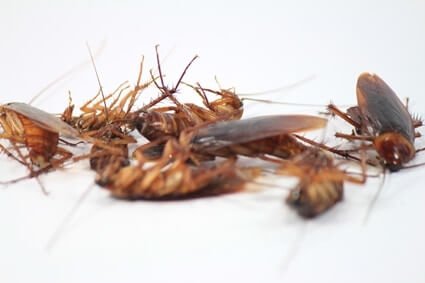
Do Cockroaches Eat Their Own Eggs?
If you thought nymphs provided a decent amount of nutrients, you can be sure eggs do as well. Roaches will consume their own eggs if food is scarce.
This is partly why mother roaches hide their egg sacs. They will be placed in dark, out-of-the-way locations, sometimes beyond the reach of the nest itself. This ensures that overpopulation is less likely to cull off the next generation. However, if driven to extreme hunger, the mothers will seek out the eggs once more and consume them.
Nymphs may also eat their younger brethren while they’re still in egg form. These eggs are soft in comparison to hatched or adult roaches, making the process easier.
Do Cockroaches Eat Their Own Poop?
Cockroaches are known to eat the feces of other animals. Disgusting as it seems, there are nutrients to be found in animal waste for a cockroach. Do cockroaches eat their own poop, though? The Medical Entomology and Zoology said that they don’t unless they are starving and have no other options available.
That’s because cockroach poop has few nutrients. Unlike certain animals, which recycle feces (or poop-like cecotropes) into their diet, roaches cannot sustain themselves this way. Instead, they rely on the feces of other, usually larger animals, because these can expend a greater amount of trace vitamins, minerals, fats, or proteins into their waste.
In an experiment using smoky-brown cockroaches, scientists found that roaches would resort to cannibalism before coprophagy. Even then, eating their own feces drastically reduced their lifespan. Nonetheless, cockroach nymphs will eat their own feces. Scientists are exploring why this option is more appealing to young roaches.
Do Cockroaches Eat Molted Skins?
Cockroach nymphs will eat their own molts and those of their siblings. Adult cockroaches will also eat shed molts. That’s because these skins retain nutrients, even after they’re used up.
Among the nutrients is chitin, made of fiber and polysaccharides. This component is what makes exoskeletons so hard and durable. By consuming that otherwise wasted resource once more, roaches can add it back into their system. This will fortify their bodies to create new skins in the future. After all, most will only molt their exoskeleton to grow in size, not because there was anything wrong with their shell.
This is especially important for nymphs. They will need to molt another 13 times before completing their growth cycle. If they don’t develop a hard shell, they’ll be cannibalized by other roaches. Obviously, if there is a reliable food source nearby, the cockroach may leave its shed skin to rot.
Do Cockroaches Eat Other Insects?
Cockroaches are not picky eaters. Any dead insects that a cockroach finds will be consumed. This includes shed skins, eggs, and larvae.
The strength of their mandibles limits roaches. Their size in comparison to other bugs will also deter them. Beetles, for example, will be less appealing to a roach than flies because they must contend with the hard outer shell before it can consume the beetle. Even if it found a dead one, it may struggle to gnaw through its exoskeleton.
Roaches Aren’t Hunters
Roaches understand their position as prey in the food chain. They will not tangle with stronger, more flexible, or otherwise more dangerous bugs. The risk to themselves is rarely, if ever, worth the trouble. Unappealing bugs to eat will include live centipedes, certain kinds of spiders, or scorpions. Exceptions may include bugs that are:
- Injured and unable to fight or escape
- Sickly
- Weakened by insecticide
However, this will always be a last resort. Even more easily dominated prey, like mites, flies, or ants, will be outside the cockroaches’ normal realm of expertise.
Can You Make Roaches Eat Each Other?
There’s no direct method of forcing roaches to eat each other. Despite using pheromones to influence each other’s actions, cockroaches lack any ‘attack at will’ signal that humans could manipulate.
You can limit a colony’s access to food, which will deter the infestation from settling in your home. For existing colonies, this lack of food will also motivate them to resort to cannibalism.
Cannibalism And Poisoning
You can, however, use cannibalism to poison the colony through roach traps that use a form of poisoned bait.
- Once a roach consumes it, the roach may return to the colony and then be eaten.
- The cockroach that eats this poisoned roach will then die as well.
- Any cockroaches that use this opportunistic kill to snack on stray limbs or droppings will also die.
This is more time-consuming than other pest control methods. On the whole, roaches are willing to eat anything they can. This may include eating their young, each other, and their own poop.
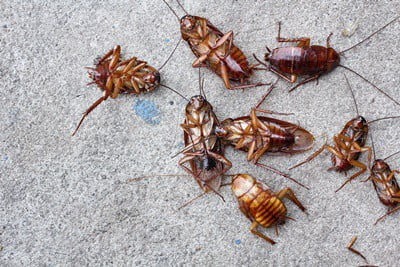
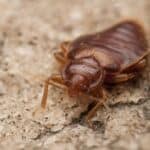
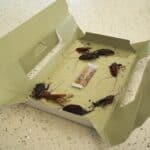

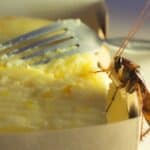
This was quite interesting and informative!
Roaches are an on/off issue in our house. Some times of the year they show up in hordes, other times we don’t see a single one. Last night I killed a cockroach in the bathtub that arrived through the drain, went to get something to take it out with, then came back to see 4 other cockroaches devouring it! It was such a surreal and disgusting sight, it gave me goosebumps, the bad kind. The cockroaches also seemed overly excited and alert, their antennas were rapidly moving, and they were moving back and forth from the drain to the dead body as if preparing to flee at the nearest sign of danger, which fits with the information you provided here about the recent death of one of their own alerting them to danger, but it seems they were too hungry they took the risk anyway. Ended up with 5 dead roaches in the bathtub and gave up on taking a bath that night LOL.
Your perspective of explaining the roach’s world is the best I’ve read. ‘Very logical to the point of even calming. My mind has been in a panicky, hyper mode since my son has been transporting roaches from his job to our yard & garage. -Both Turkestan and Oriental. I’m worried that my situation will be long term… How to get his parking area controlled, I don’t quite know. You have a gift of a Teacher. Thank you so much for your thorough research; I learned a lot. 🙏🤗 ~Sincerely, Gin